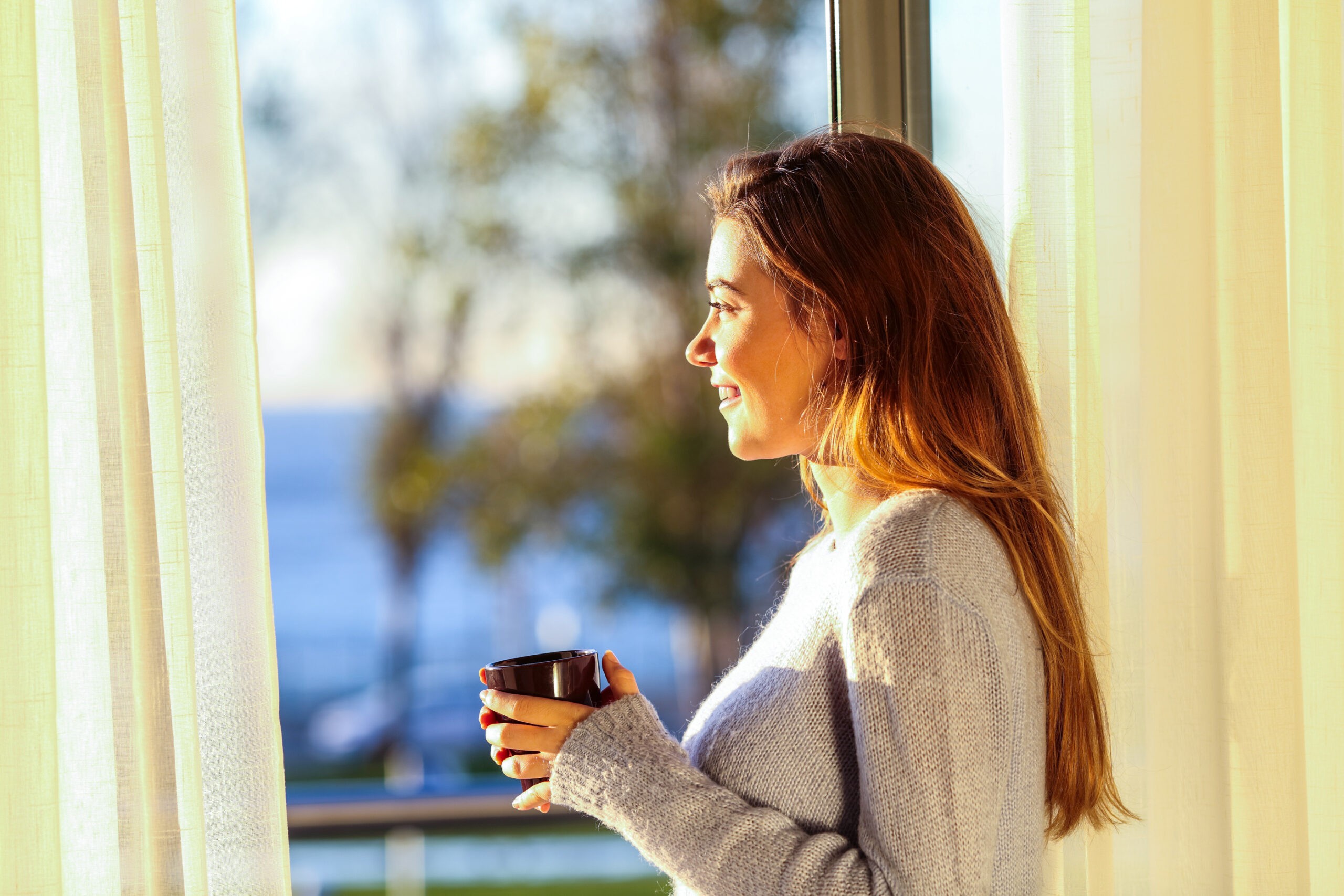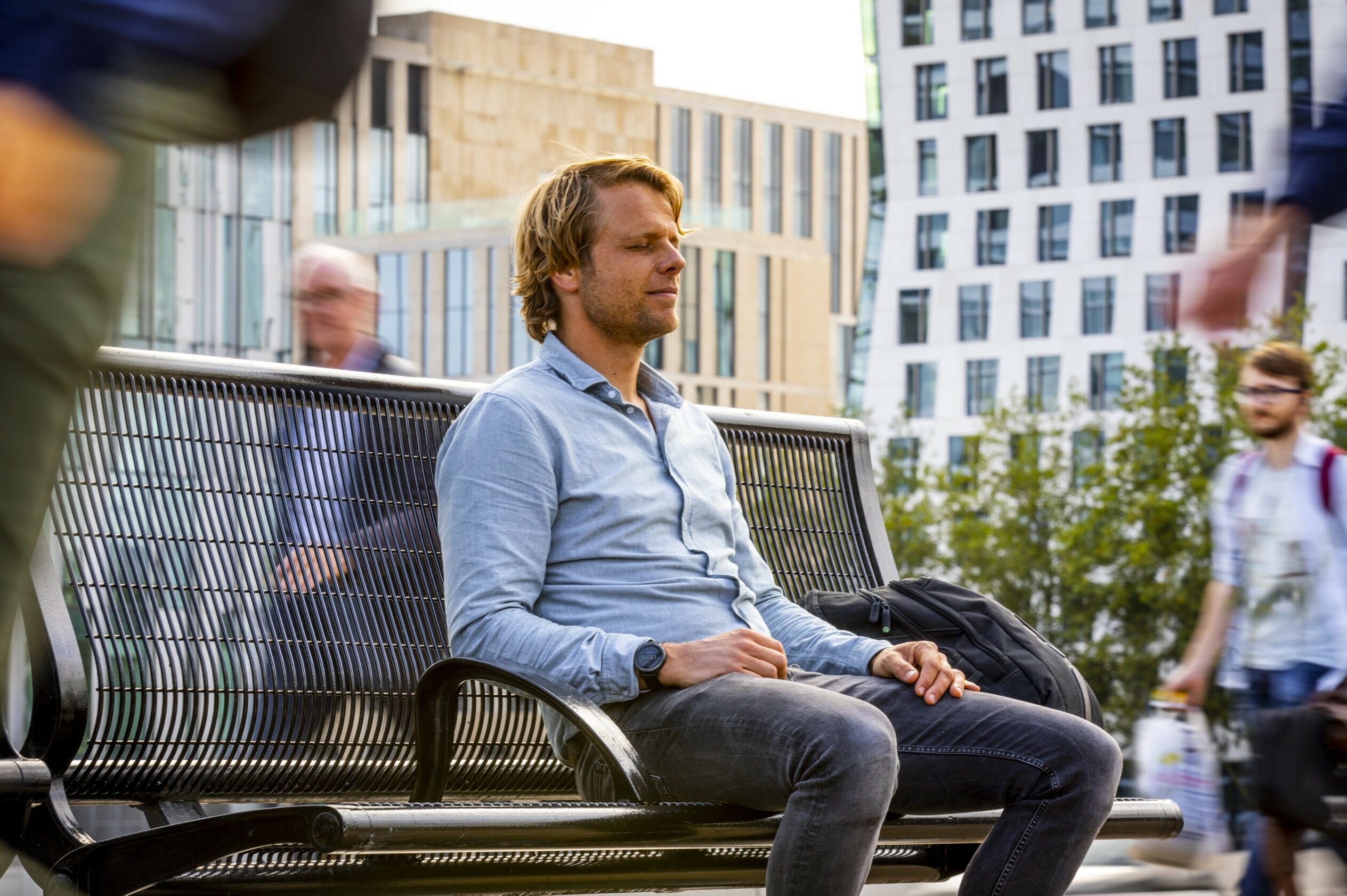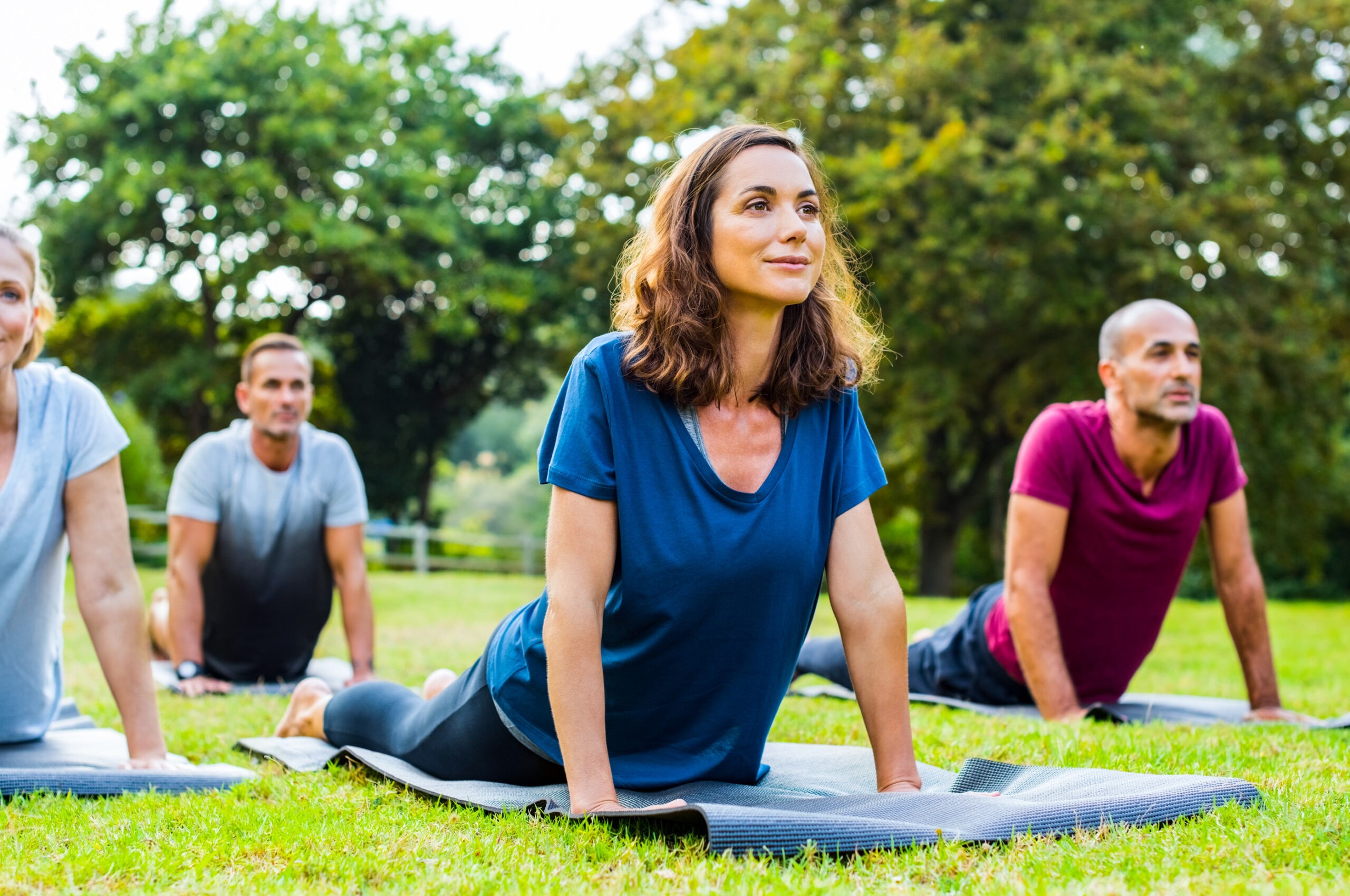Practice a Relaxation Technique
Relaxation techniques such as deep breathing, meditation, mindfulness and yoga each have the ability to activate your relaxation response; a state of deep restfulness that is the opposite of the fight-or-flight mode or mobilization stress response.
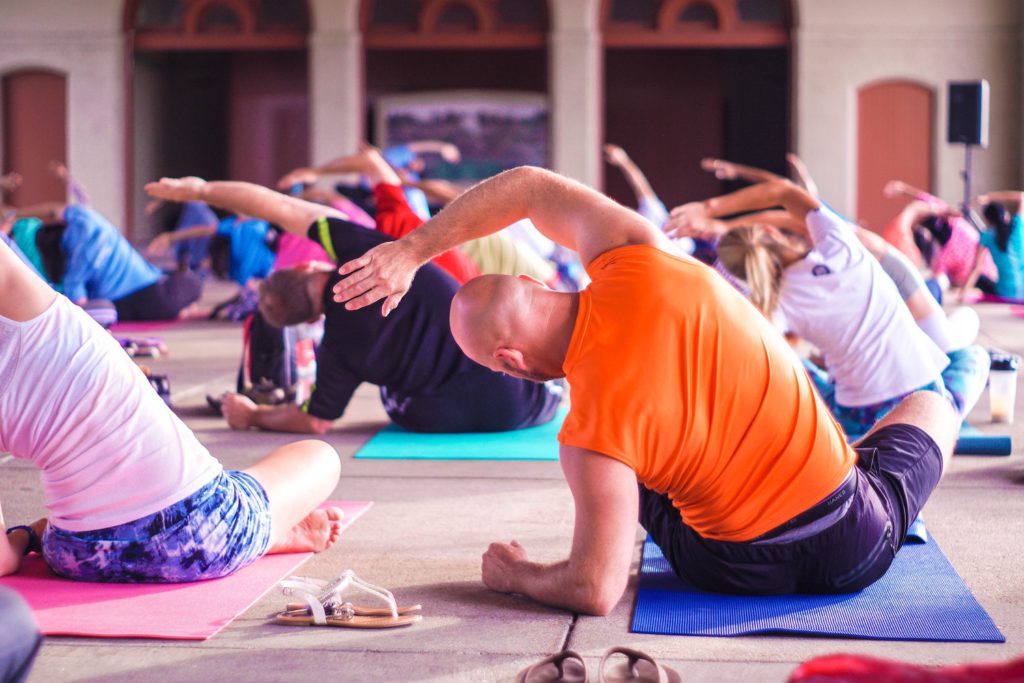
While all these techniques are different in many ways, they all demand your focused attention; they all include the repetition of a word, a sound, thought or phrase, or muscular activity and the active return to the repetition when other thoughts intrude. That is how they stop the process of your everyday thinking.
It may take some discipline and practice, but these active relaxation techniques are true superchargers; they allow you to calm your mind, decrease your stress levels, recharge your batteries, improve your focus, and much more.
Just Breathe
The easiest way to trigger your relaxation response is probably by focusing on your breathing, and nothing but your breathing. It may feel a bit awkward in the beginning, but at the same time, practically anybody who starts regular breathing exercises soon gets used to it, and finds it to be a very powerful relaxation tool.
In general, when you are doing a breathing exercise, you will breathe deeper than you would normally. Breathing deeper, using your abdomen, referred to as abdominal breathing or belly breathing, lowers your diaphragm. This gives your lungs the space they need to fully expand and fill up with air, from top to bottom, and allows you to maximize oxygen exchange.
Breathing deeper will also automatically stimulate the parasympathetic nervous system, lower your heart rate and increase your heart rate variability (HRV) as deep breaths simply take longer than superficial ones. This is even more so when you extend your exhalations. For instance, breathing in for three seconds and out for four, five or six. Do all this rhythmically and you optimize the rhythm (coherence) of your heart.
Just sitting down for five minutes practicing deep breathing will affect your physiology in such a way that you are better able to focus or deliver any kind of mental or physical performance directly afterwards.
Meditation
You can think about meditation as a form of mental exercise, an active process that involves intentionally focusing your attention and letting go of your everyday thoughts.
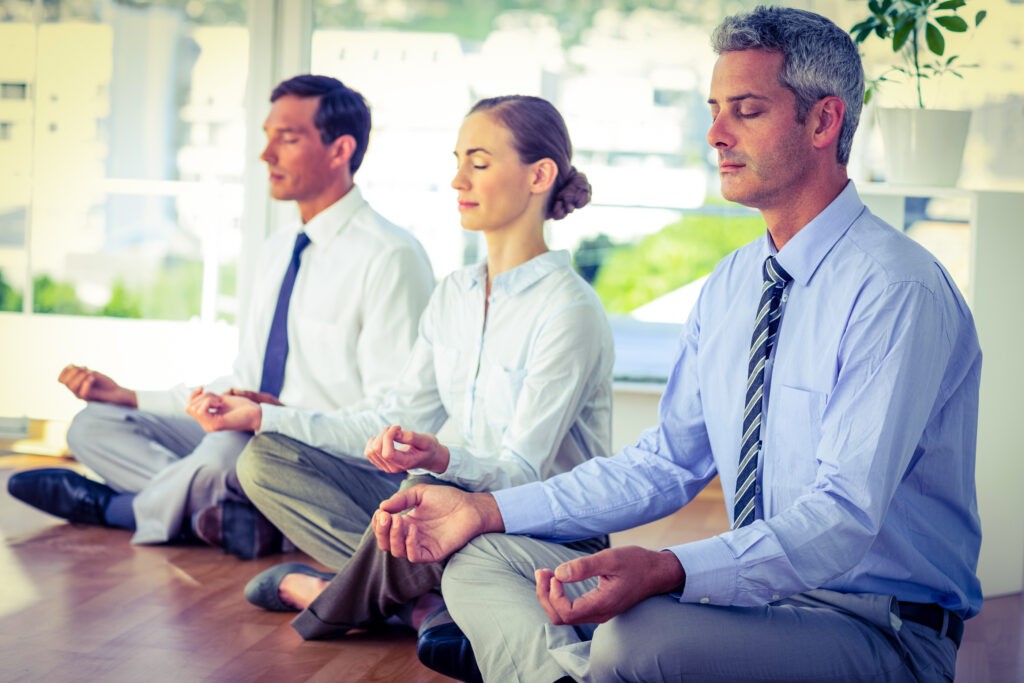
There are many different ways to meditate, despite their many differences, the vast majority of practices include two basic steps.
- The repetition of a word, a sound, thought or phrase, or muscular activity;
- The passive return to the repetition when other thoughts intrude.
These two steps combined, trigger your relaxation response by breaking the train of your everyday thinking and lessening the negative chatter that often accompanies is. This lowers your stress and improves your mood, fast and effectively.
Practice meditation regularly and you will get better at managing your stress, and at handling negative emotions like fear, anger, depression and anxiety. What’s more, you will also become (even) better at preventing unnecessary, excessive stress. You will improve your focus, have fewer negative thoughts, and thus be less distracted at any given time.
Additionally, you will improve your processing speed, cognitive flexibility and working memory. Altogether, this will help you to make more calculated choices, instead of succumbing to reactionary decisions. This will make you more effective at dealing with high-pressure situations, and also makes it easier not to act on cravings or uncomfortable feelings in your body.
Ultimately, meditation can make your better at just about anything you do. It can improve your key executive functions within eight weeks of daily practice. Over time, it strengthens key structures and pathways in your brain, giving you more control over your mind, and by extension, over your life.
Meditation for Beginners
Two popular types that are relatively easy to practice are single-pointed meditation and mindfulness meditation.
A good focus point to start with is with your breathing. Not because focusing on it offers special benefits, but because the physical sensation of breathing is always there and you can use it to focus your attention to the present moment. Throughout the practice you may find yourself caught up in thoughts, emotions or sounds. When you realize that it’s happening, just return your focus to your breath.
In the beginning, as with any activity that’s new, meditating will cost some effort, which is why you should start out with short sessions. Setting an alarm for 5 to 10 minutes will allow you get a good start. Most people find this doable, and because you are setting an alarm, you won’t have to worry about the time; one less distraction to deal with.
Mindfulness
Mindfulness is the basic human ability to be fully present, aware of where you are and what you are doing. Practicing mindfulness is returning, again and again, to the present moment, as it is. Focusing your attention on what is happening in the present and accepting it without judgment.
Practicing mindfulness offers the benefits of meditation, and is a great way to keep your mind from getting carried away in thought. Mindfulness is often practiced by meditation, focusing your attention on your breath, an image, a word or a phrase. These aspects are easy to learn and offer a powerful means to trigger your RR, thus boosting your ability to be fully present and to perform.
Practicing Mindfulness
You can train mindfulness in many ways, and most of these practices don’t take a lot of ‘extra’ time. You can train mindfulness when you’re walking in the park, listening to the birds and seeing what you see. You can practice it when you’re waiting for an appointment by following your breathing, or when you are getting a coffee and noticing the warmth of the cup in your hands and tasting the first sip with full awareness.

Mindfulness focuses on what you experience in the here and now; such as your breathing or other sensations in your body. When you are distracted by other thoughts, such as deadlines at work, important choices you have to make or financial concerns, you are doing exactly the opposite; your mind has wandered off. By focusing your attention on your breathing, or other sensations in your body, you will automatically stop thinking other – potentially stressful – thoughts, simply because your brain cannot do both at the same time. One thought or emotion is always more acute than all others. You step ‘out of your mind’ and into the present moment, anchoring yourself in the here and now.
Mindfulness Meditation
Like many other forms of meditation, mindfulness does not require that you sit in the lotus posture on a cushion. There are many different mindfulness practices, but in short, there are some basics to follow.
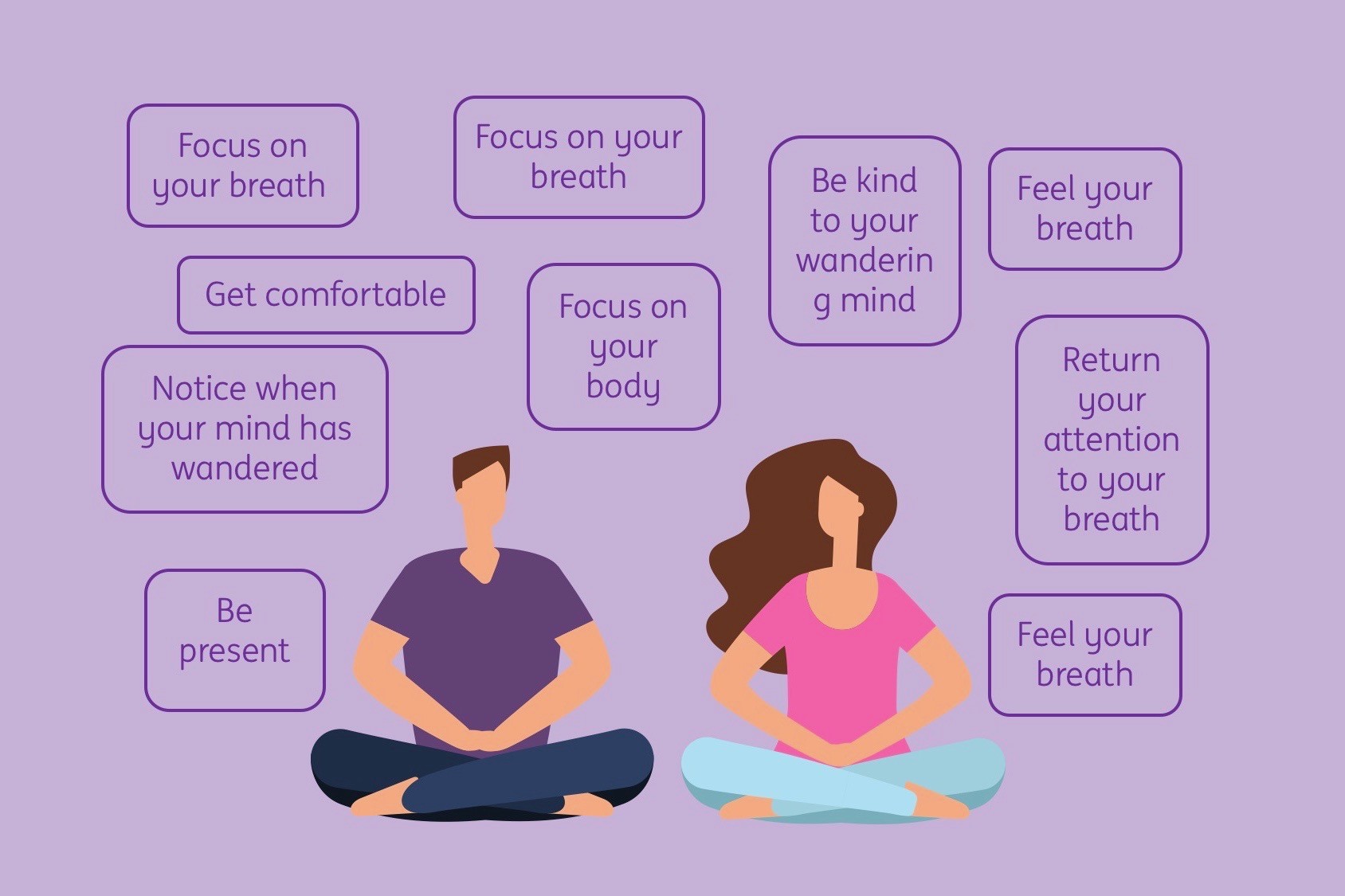
Get comfortable: Before you start, make sure that you are comfortable. Find a quiet place where you won’t be disturbed. If you choose to sit, then your body should be in a relaxed yet active position. You can sit in a chair with your feet on the floor, you can sit loosely cross- legged, in lotus posture, you can kneel – all options are fine. Just make sure you are stable and in a position you can stay in for a while.
Be present: Pay attention to the present moment, without judgment. I know that this is easier said than done, but just give it a go. The aim is not quieting the mind, or attempting to achieve a state of eternal calm. It’s just to observe the present moment as it is.
Focus on your body: Feel your feet on the ground, your back and shoulders leaning against the backrest of your chair. Focus for a few seconds on your body. Is it tense? Try to let it go for now and notice what is going on in your body.
Focus on your breath: Bring your attention to your breathing. Feel the air coming in through your nose and throat, and picture it moving downward, deep into your lungs and notice that your belly rises and falls every time you inhale and exhale.
Feel your breath: Follow the sensation of your breath as it goes in and as it goes out, without trying to change or do anything to your breath, just be aware of the rhythm of your breathing. It may help to say to yourself ‘in-out’ with each breath.
Notice when your mind has wandered: When your mind drifts off, make a note of it and move on; return your attention to your breath.
Be kind to your wandering mind: Don’t judge yourself for what- ever thoughts come up, just practice recognizing when your mind has wandered off, and gently bring it back.
That’s the practice. That is all there is to it.
Easier Said than Done
It’s often been said that it’s very simple. So simple that many people who don’t practice mindfulness, have a hard time believing that something so simple can be so powerful, and in many cases life changing. Simple does not necessarily mean that it’s easy. You need some willpower and motivation to sustain the activity of refocusing your attention and just be.
The trick is to just keep doing it, and the results will come. Begin with 5 minutes a day and gradually increase the time that you practice, as you feel more comfortable. As you progress, aim to increase to 10 minutes. This will allow you to obtain all the previously mentioned benefits in just 8 weeks; allowing you to feel calmer, more grounded, and more in control.
Need Meditation Motivation?
For inspiration and a no-nonsense guide to meditation, read Unplug, by Suze Yalof Schwartz. This easy-to-read, practical handbook offers extensive insight on the workings of meditation, as well as a host of practical tips.
Mediation Guides
For guided meditations, which can really help you to get off to a good start, consider downloading one of the three following apps: Headspace (www.headspace.com), Insight timer (www.insighttimer.com) and Calm (www.calm.com). They each offer many guided meditations. The first two are especially good at helping beginners, and the latter has a more user-friendly subscription model, which is one of the reasons they are popular with many experienced practitioners.
What if You Don’t Want to Meditate?
If you don’t feel like meditating, there are many other relaxation practices, that enable you to trigger a powerful relaxation response, and that offer comparable brain benefits, simply because they include the very principles that are the foundation of meditation. One of the practices, my favorite, is yoga.
Yoga
Practicing yoga affects nearly every major system of your body and it allows you to trigger your relaxation response, and thus lowering stress and anxiety – on demand.
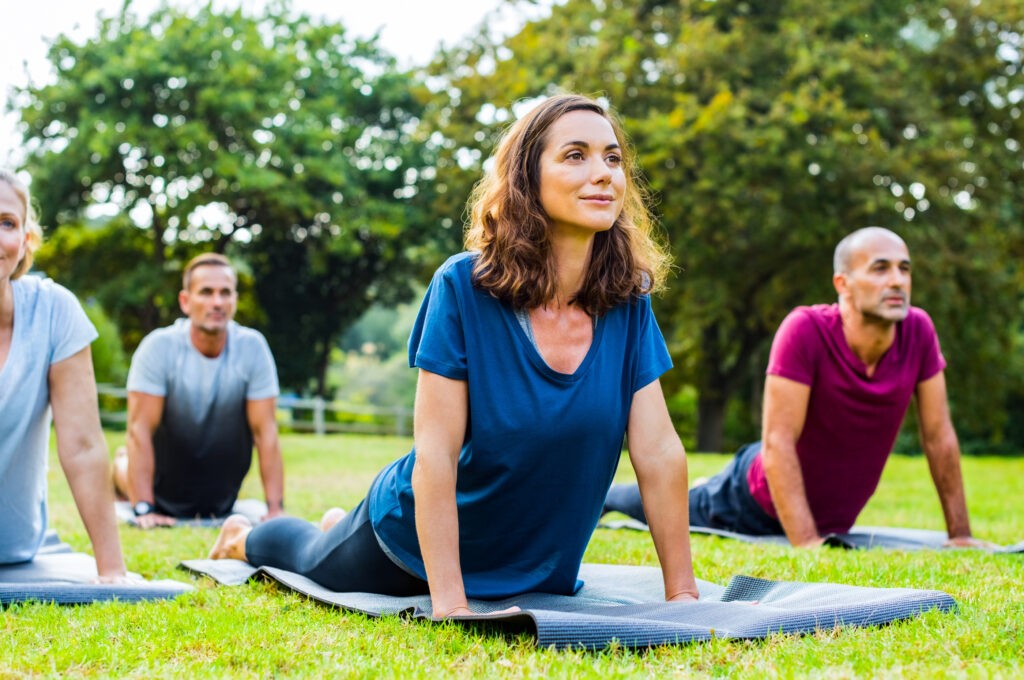
It also improves your muscular strength, flexibility, core stability, and both your mental and emotional capacities, allowing you to focus better, think more clearly and better manage your emotions. It also improves your sleep and reduces your risk of developing cardiovascular disease, diabetes, or back problems, all in one go! Yoga is arguably one of the most powerful tools for building both physical and mental resilience. People who practice yoga regularly experience more positive emotions, they are generally happier in life and experience an overall enhanced wellbeing compared to those who don’t.
The cool thing is that it’s easy to do. Yoga combines physical activity, breathing exercises, meditation and (deep) relaxation. It’s the unique combination of these components that makes yoga such a powerful body-mind workout.
Mindfulness in Motion
It is unclear which of the components is the most powerful driver behind the many positive results of yoga. However, the ‘meditational component’ that is integrated into the exercises (observing yourself and bringing back your attention as mentioned earlier), is widely considered to be responsible for triggering the relaxation response and many of the positive effects on your brain. It is this aspect that makes the practice ‘truly yoga’ in the eyes of many, and it is the reason why yoga is often referred to as ‘meditation in motion’.
The Key Components of Yoga
There are many different schools of yoga, which differ significantly. While they each emphasize different components, and vary in intensity, they generally integrate the same four components: Poses (Asana), Breath Control (Prayanama), Meditation (Dhyana), and Deep relaxation (Savasana).
Where to Start with Yoga?
There are so many different schools of yoga that it can be challenging to nail down which one is best for you. Restorative yoga is more focused on deep relaxation while ashtanga and power yoga can be a rigorous workout. Some of them are easy to pick up and others are more advanced. Two popular forms that are good to begin with and combine all four key components of yoga are Hatha and Iyengar.
Hatha Yoga
This is one of the most popular styles. It is a more physical type of yoga, rather than a still, meditative form. It combines breathing exercises with holding poses at a slow pace. It focuses on strengthening and stretching your body, while holding poses for several breaths. Most Hatha classes include some deep relaxation at the end. Hatha is very accessible to beginners, because the poses are relatively simple and are performed separately, as opposed to flowing from one to another. When you are starting, this kind of yoga allows you to get used to the different poses. Hatha sessions generally start with breathing exercises (prayanamas). They are followed by a series of postures (asanas) and the sessions end with relaxation (savasana), preparing the body for deeper spiritual practices such as meditation.
Iyengar Yoga
Named after and developed by B. K.S. Iyengar, it is considered a form of hatha yoga. The trademark of Iyengar yoga is the intense focus on proper body alignment; exploring the subtle effects that slight changes in postures have on the body. During a typical Iyengar-class, poses are held relatively long and are combined with breath control (pranayama). Another thing that is typical for Iyengar is the use of props, such as blocks, belts, bolsters, chairs and blankets. These are used to help people perform the postures correctly and support people with tightness or injuries, making Iyengar yoga accessible to beginners, both young and old.
Both Hatha and Iyengar yoga are taught in all corners of the world, and there is an endless number of online classes that you can choose from.
Next Level Yoga
There are so many more advanced styles of yoga, and even more spin-offs (hundreds), that it would be a waste of time to try and offer a complete list, let alone for you to read about all of them. Having said that, there are a few common styles, which are definitely worthwhile knowing about, if you already have experience with yoga and are looking for practices with greater diversity, depth and challenge, these are vinyasa (also known as flowing yoga), astanga (a very dynamic and athletic form that can help increase your overall fitness), yin yoga (a quiet and, slow-paced style that seems almost passive, but it can be quite challenging due to the long holds), and restorative yoga (a gentle practice, that promotes deep relaxation).
Whatever class you join, don’t forget to:
Leave your ego at the door: Yoga has nothing to do with competition. Stronger, more flexible classmates are not necessarily better at it than those who are less flexible or have injuries. Having said that, many people who practice yoga, especially those who have been at it for a while, find it hard not to compare themselves to others. The trick is to notice when you are making comparisons, accept that you are doing it (you are only human) and then refocus on you; feel your body and your breath. It is not a competition.
Breathe: It’s not uncommon for people, especially when they are learning new positions, to forget to breathe. It is important to focus also on your breathing. Inhale as you stretch or strain, and exhale as you release.
Drink enough water: Although yoga doesn’t always seem like hard work, it often is. Even if you are doing a less demanding, restorative form, it is always good to drink water during practice. These mini-breaks can help you to refocus between poses. Bring a bottle of water with you and make sure to drink it up!
More About Yoga?
For more inspiration and online yoga practices, see www.yogajournal.com, this is one of the most comprehensive online yoga sites available. Founded in 1975 by members of the California Yoga Teachers Association, Yoga Journal offers extensive information about many different yoga styles, including a guide to poses and a tool to help you combine your favorites into a sequence or personalized class. Other great sources of information about yoga and online classes are www.ekhartyoga.com and www.doyogawithme.com.
Muscle Relaxation
Over the course of the day the muscle tension in your body slowly increases due to prolonged sitting, lack of movement and the build-up of stress, stressful thoughts, frustration or anxiety. Two simple techniques that can reduce muscle tension effectively, and additionally trigger your relaxation response, are stretching and Progressive Muscle Relaxation (PMR).
Stretching
By stretching, you increase the blood flow to your muscles and loosen their fibers. This creates space inside your muscles, which allows for waste materials that were built up due to excessive tension, to be washed away. Additionally, stretching will trigger the release of endorphin, which lowers pain (including muscle aches) and makes you feel better.
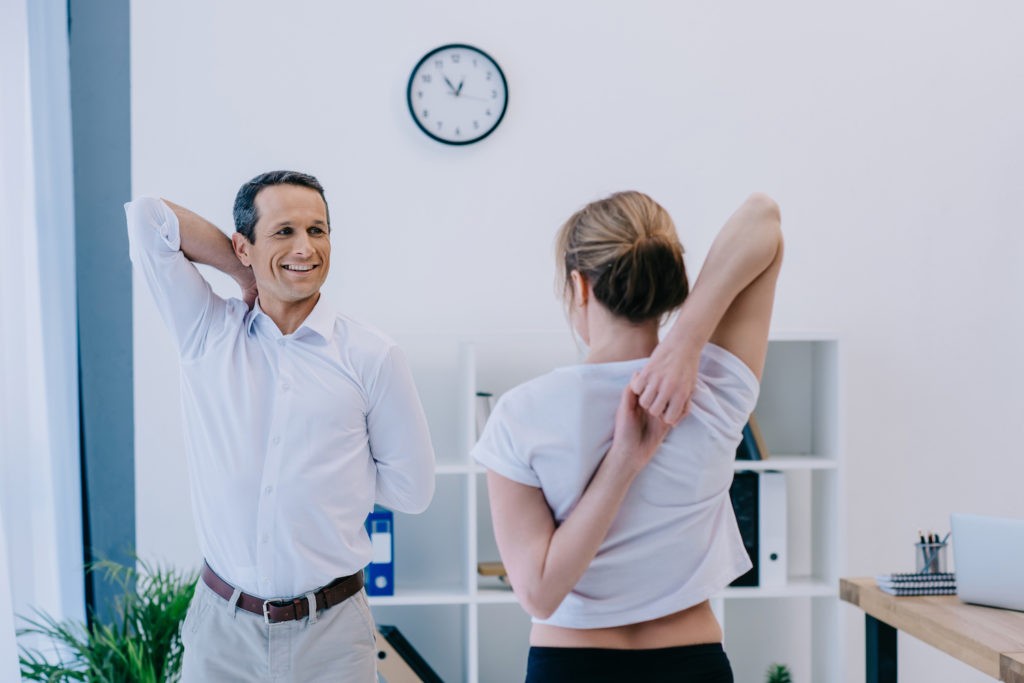
To stretch your muscles, slowly and gently lengthen them until you feel a non-painful stretch, hold it there for 10 to 15 seconds, and then let go. Include all your tightened muscles or muscle groups. Repeat the stretches a few times, with full focus, and you can trigger a powerful relaxation response in minutes. That is what makes this simple technique especially effective near the end of a long day.
Progressive Muscle Relaxation (PMR)
PMR is a simple and effective relaxation technique, which you can use to relax yourself from head to toe. When you do PMR, you squeeze and release your muscles in one part of your body at a time, and repeat as many times as you like.
PMR builds on the physiological certainty that muscles automatically relax, after contracting them, and has been proven to be highly effective in a wide range of studies.
Regular practice will trigger a powerful relaxation response, making PMR a great go-to technique when you are dealing with high levels of stress and physical tension.
Practicing PMR includes a whole series of muscle groups.
Generally, you start with your facial muscles and then work your way down to your feet: exercising your Facial muscles – Eyes & jaws – Shoulders – Arms and hands – Abdomen – Legs – Calves – Ankles and feet, or you start off with your feet and work your way up to your face.
To experience how PMR works, all you have to do is the following: Get comfortable – Tighten your muscles – Release your muscles – Go to the next muscle group – Take your time.

